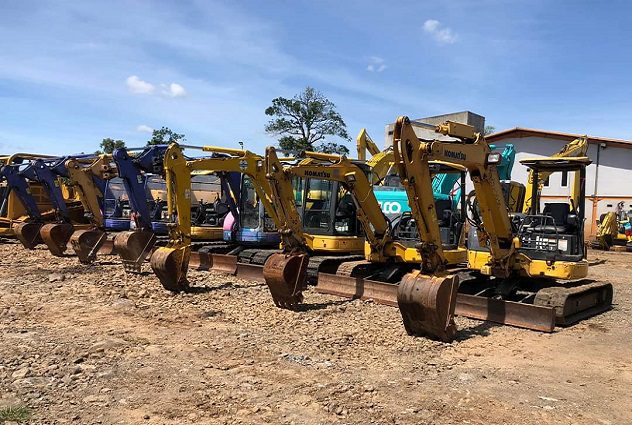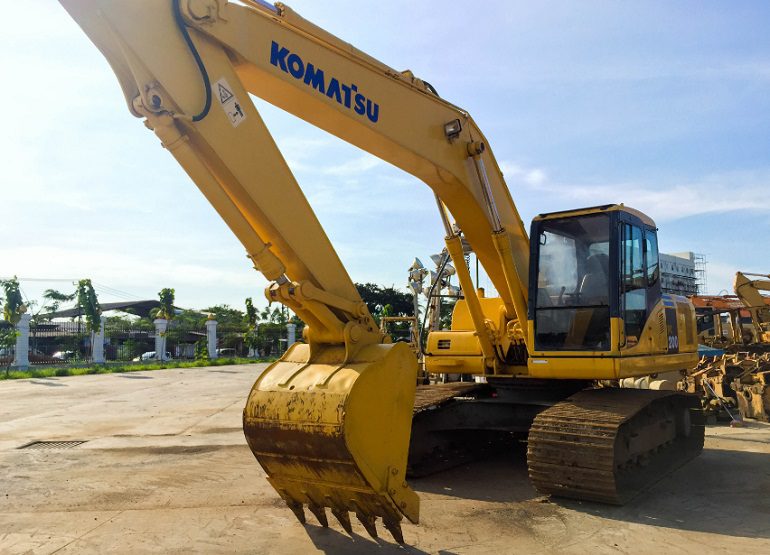Excavator or commonly called excavator is a type of heavy equipment that is often used in construction projects, mining, and forestry. In Indonesia itself, This heavy equipment is often referred to as beko or begotten.
Excavators are always relied on in building and infrastructure construction projects because they have a variety of uses that make work easier. The function of an excavator is to dig, dredge, to move or transport land.
In its use, the excavator has parts bucket or a dredging tool for digging or taking soil. Excavator operations must be carried out by specialized operators who understand how this heavy equipment works.
Remembering its role is very important to make work easier, Everything about excavators must be understood by operators and project developers. Through this article, We invite you to understand the function of an excavator, way of working, and its types.
Getting to Know Excavators
As we have explained above, Excavator or excavator is a heavy tool that works to dig, transport, and moving soil or materials. This tool is designed to help handle the heavy work that is usually involved in projects, like construction, mining, and forestry.
Excavators have three main components, that is bucket (rake), boom (bahu), arm (arm). All parts of the excavator are driven using a hydraulic system powered by a diesel engine. For the driving force, This tool uses a chain wheel (track) which allows moving on various terrains such as muddy ground and rocks.
Excavators are available in various sizes and categories with maximum weights reaching 81.500 KG (kilogram). According to the book Technology in Heavy Equipment Systems by Wawan Purwanto and team, Excavator class determines the load capacity that can be lifted or the volume of work that can be completed.
Apart from the digging bucket, There are other accessories that can be installed on the excavator, like, auger, breaker, grapple, ripper, and others. With the flexibility of using these additional tools, Excavators are capable of completing many different tasks for construction, plantation, mining, and river normalization.
Apart from its function for digging and transporting materials, Excavators also have other functions, like dredging sedimentation in a river, digging water channels, compacting and leveling the soil, to assisting in the process of dismantling materials or installing pile foundations.
What is the Function of an Excavator?
Excavator function in construction projects very important because there are many jobs that cannot be handled by direct human hands. For example, Excavators are used to dig soil and load it into trucks. The excavator can also be used to move soil by rotating the body to a 360° angle.
Although the main use of excavators is to dig or dredge soil, However, this heavy equipment also has various other functions. Often operated in the construction sector, mining, and plantations, Following are some of the excavator functions:
- Transport various types of materials, like land, stones, and mud
- Dredging mud sedimentation found in the river, lake, or the edge of the dock
- Leveling and compacting the soil surface
- Dismantle materials to install pile foundations
- Dismantling or demolishing buildings
- Knocking down trees
- Help handle work that is still related to mining and forestry activities
Here's How It Works Excavator and Operate it
Operating an excavator should not be done by just anyone. Only those with certification are permitted to operate this machine, especially in large projects and large-scale industries.
Besides that, To control an excavator also requires courage and a strong mentality. Excavator operators must also understand work safety techniques and how to operate this heavy equipment considering that there are various types of excavators.
In operation, it is also important to understand the terrain conditions and the appropriate type of excavator. If you encounter muddy terrain, it is best to use a type of excavator crawler, while for flatter terrain, excavator type wheeled more appropriate to use.
Here's how an excavator works that beginner operators or those of you whose work is related to this heavy equipment need to understand:
- Travelling left and right shoe: move the excavator forward and backward freely for mobilization from one area to another.
- Raise down: how an excavator works that allows it to move up and down.
- Swing: allows the excavator to make a full rotation 360 degree according to the control of the operator. The diesel motor on this tool will move it liver to open the valve control valve.
- Arm in out: part arm on excavators can also be driven by arm cylinder. This way of working allows hydraulic pressure to move arm cylinder to open and close.
Simply, description of how the excavator works by the operator is as follows:
- When the excavator operator moves joystick (control lever), signal is sent to the hydraulic system.
- The hydraulic system will move the bucket, boom, and arm according to the operator's command.
- Bucket or the dredging part then works to dig up soil or other materials, then lifted it, and move it to another place.
Types of Excavators
Excavator heavy equipment consists of several with their own special capabilities and functions. To recognize the difference, The following is an explanation of the types of excavators that are often used in various heavy projects and activities.
1. Crawler Excavator
This heavy equipment is called crawler because it uses a chain wheel or track on the right and left side to move. Chainwheels provide greater stability on rough or muddy surfaces. With strong grip, track allows the excavator to move over unstable ground and sloping terrain.
Crawler excavator often used in various construction activities, mining, landscape arrangement, until digging a trench. However, this tool has a slow movement speed and is often considered a standard excavator.
Comes with sleeves and bucket at the end, crawler excavator usually used for digging, load, and moving materials such as soil, batu, and sand. Advantage crawler excavator, that is, it has good stability, carrying capacity, as well as its ability to traverse uneven or difficult terrain.
2. Hydraulic Shovel Excavator
Hydraulic shovel excavator also known as a power shovel. This type of excavator has capacity bucket which is bigger than crawler excavator. This tool is designed to handle large-scale excavation work, especially in the mining industry.
Compared to other types of excavators, hydraulic shovel has very large lifting capacity and the ability to dig material quickly and efficiently. Because of its extraordinary power, This tool is often chosen for projects that require handling large sizes of material, like a rock, mineral, coal, and other materials.
Apart from being often operated in mining, hydraulic shovel also used in other large construction projects that require moving large amounts of material. Its flexibility and high lifting power make it an ideal choice for various construction and other large-scale excavation sectors.
3. Wheeled Excavator
Wheeled excavator is heavy equipment that is often used in the construction and mining industries. In appearance, this tool looks similar to crawler excavator. However, there is a difference in the driving force. This type of excavator uses tire wheels, not a chain wheel (track) as in crawler.
Wheeled excavator equipped with arms and bucket at the end for digging duties, load, and moving materials. This tool is also equipped with a diesel engine, hydraulic system, pulley, and cabin controls, which makes it easier for operators to operate it.
Main advantages wheeled excavator is the ability to move quickly on roads and more stable terrain. This tool is very supportive for projects in urban areas or locations with easily accessible terrain. Unfortunately, this type of excavator is less stable and has limitations in traversing difficult or uneven areas.
4. Suction Excavator
Suction excavator is heavy equipment that uses air pressure or vacuum to dig and remove material from the ground. Different from conventional excavators which use arms and bucket, This tool uses a suction pipe that draws material with air pressure from a suction machine.
This tool is often used for projects in difficult to access or vulnerable areas, such as work on underground cable networks, gas pipe, or water. The suction technology on this excavator allows digging without damaging underground infrastructure.
Suction excavator consists of several components, including a suction machine that creates a vacuum, suction pipe to draw material, as well as a storage tube to accommodate the sucked material. The operator controls it from the control cab on the truck or trailer which carries a suction system.
Suction pipe on suction excavator can also work with a water jet which allows suction of debris or soil at up to speed 320 km/hour. Although it has advantages, These excavators are limited in their suction capacity and are not suitable for unstable or difficult-to-access terrain.
5. Long Reach Excavator
Long reach excavator is heavy equipment specifically designed to reach hard-to-reach areas and carry out work that requires a longer reach. Different from ordinary excavators, This tool has a longer and more flexible arm. So this type of excavator is capable of digging at greater depths and distances.
This excavator arm can be extended to 30 meter, both for length and depth. Therefore, long reach excavator often used for projects in difficult locations such as dredging lakes or rivers. This tool is also used in bridge construction projects, harbor, and others.
Long reach excavator equipped with several components, includes flexible long arms, bucket at the end of the sleeve, as well as a diesel engine that powers the hydraulic system. This hydraulic system is what moves the arms and bucket for digging and loading materials.
The main advantages of long reach excavator is the ability to reach hard-to-access areas and dig deeper. This tool also saves time and costs on projects because material can be lifted directly from the depths without the need for additional handling.
6. Dragline Excavator
Dragline excavator is heavy equipment whose function is to dig up soil or materials using a large bucket driven by a chain or steel cable. Bucket capacity on dragline excavator usually very large, it can even reach tens to hundreds of cubic meters.
This tool has a triangular arm connected to a large pole, with the bucket hanging from the end of the arm using a steel cable or chain. The operator in the control cab controls the movement of the bucket forward and backward to pick up the material to be excavated.
Dragline excavator generally used in digging coal mines and other mining materials. Besides that, This type of excavator can also be used on large construction projects such as digging canals and building dams.
Superiority Dragline excavator is its ability to handle very large volumes of material. Besides that, This tool also provides efficiency in digging and has a wide reach. However, it takes time to set up and position this tool before it can be operated.
7. Skid Steer Excavator
Skid steer excavator is a type of small excavator that is very versatile and suitable for use in limited areas. Even though the size is small, This tool is very efficient for cleaning debris and other materials. However skid steer not ideal for uneven or muddy terrain because it uses tires as a driving force.
This type of excavator is able to move very nimbly and is suitable for use in narrow spaces. Skid steer excavator usually equipped with wheels and can rotate 360 degrees, making it easier to maneuver and turn quickly.
Usually Skid steer excavator equipped with buckets or other digging tools that can be replaced according to work needs. This tool can also be equipped with additional accessories such as a fork, hydraulic hammer, and concrete cutter, which increases its flexibility for various types of work.
To operate it, operator skid steer excavator sits in the control cabin and controls the movement with two levers. This lever functions to control the back and forth movement as well as the rotation and tilt of the tool.
What are the Parts of an Excavator?
The components or parts contained in the excavator need to be understood before operating this heavy equipment. Besides that, The components in the excavator also need to be understood to be able to carry out proper care or maintenance.
The following components of the excavator that you need to know:
1. Cabin
One of the main components of an excavator is the cabin or also known as cab. The cab functions as a control room where the operator operates this machine.
Generally, the excavator cabin only has a capacity for one person and is tasked with operating this machine. Apart from functioning as a control center, The cabin also plays an important role in ensuring operator safety and comfort while working in the field with Roll Over Protective Structure technology (ROPS) dan Falling Object Protective Structure (FOPS).
2. Machine
This component is the main source of power that drives an excavator. On excavators marketed in Indonesia, The diesel engine is placed at the rear of the cabin and is quite large.
Therefore, the machine is equipped with counterweight (balancer) which functions to maintain the stability of the excavator when operating in heavy terrain. Just like any other vehicle, Excavator machines also require routine maintenance so that they can continue to work optimally.
3. Track
Roda rantai (track) The excavator has similarities to the wheels on a tank, namely covered with iron chains. This design allows the excavator to move easily over rough and steep terrain, such as in coal mining areas, nickel, it's not, and others.
4. Boom
Boom or often called stick is a component that works to connect the cabin with arm. With sufficient length, boom role in making it possible arm reach farther areas. This really supports optimal performance when carrying out excavations or other tasks.
As a vital part of the excavator, boom It needs to be maintained and checked regularly so that it remains in prime condition and can work efficiently. Damaged or worn booms can reduce performance and potentially endanger operator safety.
5. Arm
Arm is a component that connects parts boom with bucket on the excavator. Its role is very vital because it allows the bucket to reach farther areas and move more flexibly.
On components arm there is arm cylinder tube-shaped. Arm cylinder works to move arm. Besides that, there are also bucket cylinder which functions to move the dredge. These two components are very important to ensure the excavator operates properly and efficiently.
6. Bucket
Bucket is one of the main components of an excavator which is shaped like a basket with teeth at the end. This component provides the main function of the excavator, namely to excavate material. Teeth on bucket plays an important role in facilitating the excavation process.
There are several types bucket which can be used according to the work being carried out. Ada slope bucket designed to level the surface. Rock bucket with looser teeth to penetrate rocks and pull out roots. There is also clamshell bucket which can clamp and move vertically.
7. Swing Drive
Swing drive is a component that allows the excavator to rotate up to 360 degrees. This component functions as a link between the excavator body and the chain wheel. With a swing drive, operators can easily work in various directions according to the conditions of the area being crossed.
What is the name of the excavator foot?
The excavator's foot is called ‘track’ which looks similar to a tank wheel, namely wheels covered with iron chains. Excavators use a chain wheel system to provide stability and strong grip to traverse various types of surfaces.
The chain wheels on excavators are designed to handle difficult or uneven terrain such as soft or rocky ground. Besides that, on type wheeled excavator using rubber tire wheels.
Is an Excavator the Same as a Bego?
Excavator and begotten often referred to interchangeably as the same heavy equipment. The term excavator is the official name for this heavy equipment. Temporary begotten is a term in local or 'slang' language for heavy equipment that has the function of digging and dredging.
Actually both excavators and begotten is the same tool specifically designed for digging, transfer, and transport materials such as soil and stone. The term stupid is just another name for excavator among local people.
Need an Excavator for Construction and Mining Project Work?
Now you know that the function of an excavator is not only to dig and transport soil, but can also handle work in various projects. Each with its own special abilities and uses, The choice of excavator type must also be adjusted to the needs of the job.
For those of you who are working on or planning a construction project, preparing the excavator is mandatory. Make sure to use an excavator from a trusted provider. To answer these needs, PT Perkasa Sarana Utama (PSU) present as a specialist in heavy equipment rental for building construction, industry, mining, and others.
With long experience 20 year, We provide a variety of heavy equipment that is of high quality and guaranteed safety. Apart from excavators, We also rent other heavy equipment and are equipped with legal documents such as SIO and SILO to ensure your work runs smoothly without any obstacles.
We also guarantee that all heavy equipment is always in prime condition due to routine maintenance. Besides that, We also have professional operators who are certified and experienced in various types of projects. Our mechanical team is also ready to provide full support, 24 hour every day.
Don't hesitate to use our equipment for the smooth running of every stage of the construction project you are working on. Please ask or consult first with our team at CS Center 0811358378 or email rent@psualat Berat.com.








